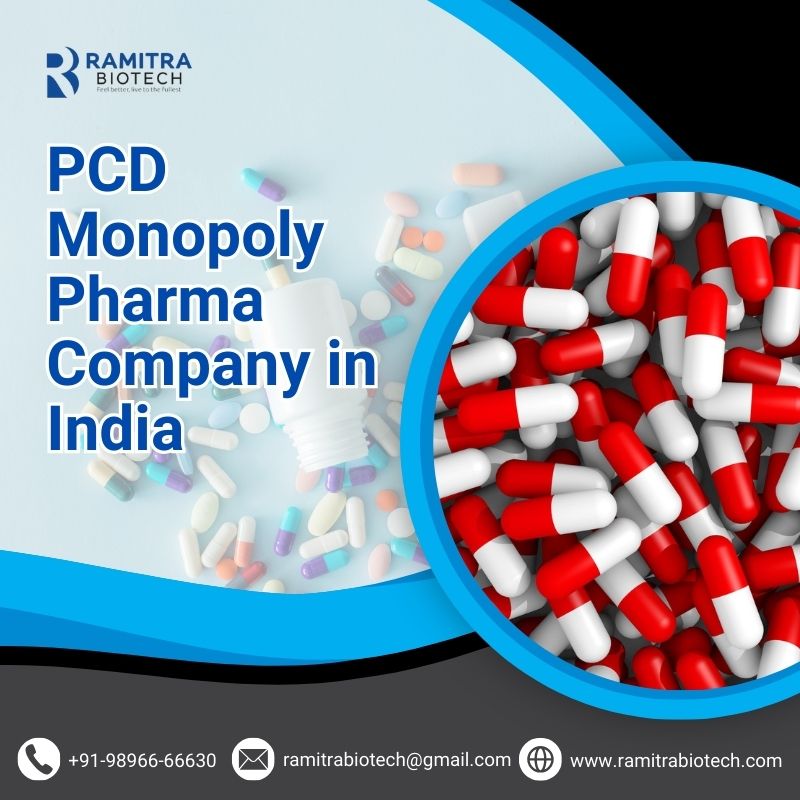PCD Monopoly Pharma Company in India

Understanding Monopoly Pharma Franchise Company
As far as pharmaceutical concerns are concerned, the word PCD may refer to the process of granting authorization to market fantastic drugs to an individual or a smaller unit to carry out distribution activities and marketing. It is a model that gives an opportunity to the minority players to venture into the market with minimum investment. But in the long run, certain companies have relied on this model to have the monopoly in a particular area of therapy or in a certain region so as to dictate terms and restrict competition.
Ramitra Biotech’s Pharma Franchise Monopoly Basis
Ramitra Biotech is founded with an aim to present pharmaceutical service at an equally lower price while keeping the quality afloat. Embracing the PCD Monopoly Pharma Company model, the company quickly got the attention of consumers across India and started concentrating on the narrow therapeutic segments like dermatology and gastroenterology. At first, our perception of the purpose was positive – improving the place where the gaps in health care are. As its growth progressed, some monopolistic undercurrents could be found surfacing within the system.
The Rise of PCD Monopoly Pharma Company
As Ramitra Biotech moved along successfully, it came up with monetary rewards to motivate its PCD members so that they would obtain exclusive rights for their regional distribution privileges. This tactic was very profitable for the company and its partners, however, at the same time, it also posed hurdles for the others trying to access the market. With time, Ramitra Biotech’s success in certain niches became irrefutable, posing threat to the rest of the industry.
Challenges Faced: After Ramitra Biotech became a leader, competitors and the industry were forced to deal with numerous challenges. Firstly, it suppressed innovation by preventing the entry of new players through the domination of marketing channels. One of the main effects was lack of variety of choices because the consumers could only get what was offered by the source. Lastly, it caused pricing pressure because companies found it was difficult to compete with Ramitra Biotech’s aggressive pricing strategies, supported by its dominant position in the market.
Impact on Healthcare: The consequences of Ramitra Biotech as a PCD Monopoly Pharma Company in India touched the business factors, outcome of healthcare services, various parties, and other important issues. Smaller number competition meant less chance for patients and may pose the risk of treatment efficacy and affordability. Besides, monopoly usually brings about higher prices experienced by patients and stretched healthcare systems. As a result, a multiple entity emerged in the healthcare market, determined the medicine availability and not the real need.
Regulatory Response: Cognizant of the harmful consequences that monopolies in pharmaceutical industry bear, regulators in India tried hard to come in with relevant solutions. Competition Commission of India (CCI) and the Department of Pharmaceuticals (DoP) were created for the objective of regulating illegal and unfair practices as well as monitoring financial practices. Although it might be difficult to guarantee the full effectiveness of these regulations, policymakers face the problem of the pharmaceutical industry being a covered by the complex nature of drug supply chains, and by the dominance of players such as Ramitra Biotech.
The Way Forward: Creating an ecosystem less complicated by a Pharma Franchise Monopoly is a multi-dimensional task in the view of all the players involved. The measures which regulators take must be strengthened for curbing illegal activities like price fixing the markets. On the top of that, promoting an environment of innovation and entrepreneurship can also encourage new players to join the competition market, which will then act as a means of diversifying existent massive players. Collaborative efforts between the government, industry, and civil society are key ingredients in an inclusive society where all compete for fair healthcare chances.
Conclusion
Ramitra Biotech’s journey exemplifies the intricate interplay between the Monopoly Pharma Franchise model and monopolistic tendencies in the Indian pharmaceutical industry. While PCD has democratized access to medicines, unchecked monopolies threaten to undermine its benefits. Moving forward, proactive regulatory measures and collaborative efforts are imperative to curb monopolistic practices and foster a competitive environment conducive to innovation, affordability, and accessibility in healthcare. As stakeholders navigate this complex terrain, the ultimate goal remains clear – to prioritize the well-being of patients above all else.




